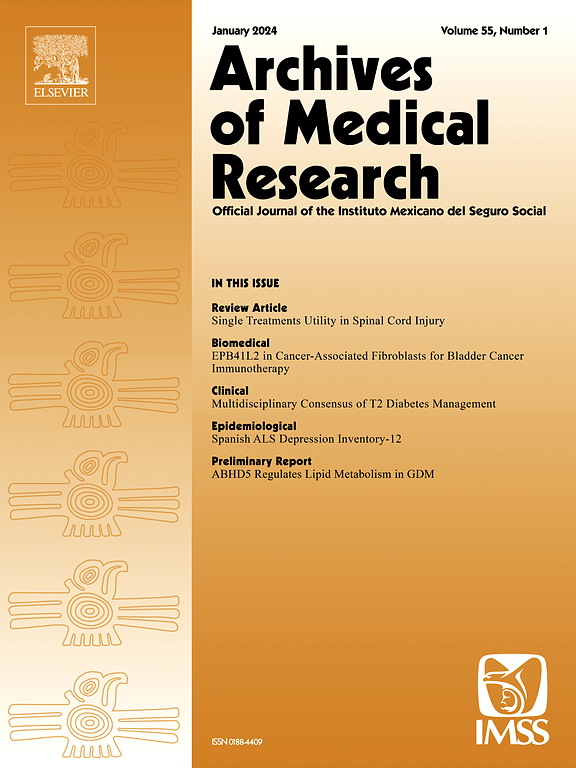墨西哥人主要组织相容性复合体I类和II类等位基因频率与疾病关联:系统回顾和荟萃分析
IF 3.4
3区 医学
Q1 MEDICINE, RESEARCH & EXPERIMENTAL
引用次数: 0
摘要
主要组织相容性复合体(MHC)在免疫应答中起着至关重要的作用,并与疾病易感性相关。本研究系统回顾了1979年至2023年墨西哥人群中MHC I类和II类等位基因频率及其与疾病的关系。方法按照PRISMA指南进行系统评价。使用HLA和墨西哥人群相关的关键词从等位基因频率网数据库和PubMed中获得报告。总共筛选了776份报告,并保留214份供最后分析。该研究分析了76项研究,包括来自墨西哥各州和土著社区的2万多人的等位基因频率数据。此外,还检查了超过138篇文章,以确定与各种疾病相关的等位基因。结果该分析确定了117个等位基因,其频率在墨西哥地区存在差异。以DPA1*01、DPB1*04:01、DQA1*03为主,DRB1*04、DQB1*03、DQA1*05也有显著差异。A*02、B*35、C*04、C*07等等位基因在人群中较为常见。许多疾病的相关性被发现,如B*27与脊椎关节病的强相关性。DRB1*15:01和DRB1*04可增加多发性硬化症,而DRB1*04可预防某些皮肤病。结论本综述提高了对墨西哥人MHC等位基因频率和疾病相关性的认识,突出了遗传多样性。这些发现为未来遗传倾向和健康结果的研究奠定了基础,有助于在这个多样化的人群中制定医疗保健策略。需要进一步的研究来解决数据缺口,并为有针对性的医疗应用改进基因图谱。本文章由计算机程序翻译,如有差异,请以英文原文为准。
Major Histocompatibility Complex Class I and II Allele Frequencies and Disease Associations in Mexicans: A Systematic Review and Meta-Analysis
Background
The major histocompatibility complex (MHC) plays a crucial role in immune responses and is associated with disease susceptibility. This study systematically reviews MHC class I and class II allele frequencies and their associations with diseases in the Mexican population from 1979 to 2023.
Methods
A systematic review following PRISMA guidelines was conducted. Reports were obtained from the Allele Frequency Net Database and PubMed using keywords related to HLA and Mexican populations. A total of 776 reports were screened, and 214 were retained for final analysis. Seventy-six studies comprising allele frequency data from over 20,000 individuals across Mexican states and indigenous communities were analyzed. In addition, over 138 articles were examined to identify alleles associated with various diseases.
Results
The analysis identified 117 alleles whose frequencies varied regionally within Mexico. While DPA1*01, DPB1*04:01, and DQA1*03 were predominant, DRB1*04, DQB1*03, and DQA1*05 were also prominent but variable. Certain alleles, such as A*02, B*35, C*04, and C*07, were relatively common in the population. Numerous disease correlations were uncovered, such as B*27′s strong association with spondyloarthropathies. DRB1*15:01 and DRB1*04 conferred an increase in multiple sclerosis, while DRB1*04 may protect against some skin diseases.
Conclusion
This review improves the understanding of MHC allele frequencies and disease associations in Mexicans, highlighting genetic diversity. The findings lay the groundwork for future research on genetic predispositions and health outcomes, aiding healthcare strategies in this diverse population. Further studies are needed to address data gaps and refine genetic profiles for targeted medical applications.
求助全文
通过发布文献求助,成功后即可免费获取论文全文。
去求助
来源期刊

Archives of Medical Research
医学-医学:研究与实验
CiteScore
12.50
自引率
0.00%
发文量
84
审稿时长
28 days
期刊介绍:
Archives of Medical Research serves as a platform for publishing original peer-reviewed medical research, aiming to bridge gaps created by medical specialization. The journal covers three main categories - biomedical, clinical, and epidemiological contributions, along with review articles and preliminary communications. With an international scope, it presents the study of diseases from diverse perspectives, offering the medical community original investigations ranging from molecular biology to clinical epidemiology in a single publication.
 求助内容:
求助内容: 应助结果提醒方式:
应助结果提醒方式:


